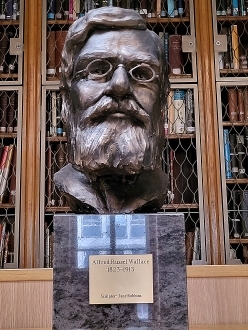His fame as a scientist was eclipsed by Charles Darwin
A SHORT CARRIAGEWAY leads from Piccadilly into the courtyard of London’s Royal Academy of Art. It passes beneath a magnificent tall archway with a curved ceiling. Within the arch there are two doorways leading from the carriageway. The one to the west is the entrance to the headquarters of the Linnaean Society. This organisation was founded in 1788 by Sir James Edward Smith (1759–1828). It is named after the pioneer of modern taxonomy, Carl Linnaeus (1707-1778). It was he who ‘invented’ the modern method of classifying and naming animal and plant species. For example, human beings form the species Homo sapiens. After Linnaeus died, Sir James Smith purchased some of his collections of specimens, books, and other items. These are now preserved by the Society (see www.linnean.org/), which is the world’s oldest surviving organisation dedicated to the study of natural history. Its mission is to understand, disseminate information about, and protect, the natural world.

Alfred Wallace in the Linnean Society library
On the first of July 1858, a paper was read to the members of the Linnaean Society. Its title was “On the Tendency of Species to form Varieties; and on the Perpetuation of Varieties and Species by Natural Means of Selection”. Its authors were Charles Darwin (1809-1892) and Alfred Russel Wallace (1823–1913). Both men had come up with the same idea independently – namely, that evolution was based on what is now known as ‘natural selection’. With his publication of “On the origin of species by means of natural selection” in 1859, Charles Darwin eclipsed Wallace as far as being recognised as the ‘father of modern evolutionary theory’. However, the two men continued to be good friends until the end of Darwin’s life. They are both amply celebrated for their achievements by the Linnaean Society.
Apart from making adventurous trips to study species and their variations in the Malay Archipelago – studies that led him to develop his ideas about evolution – Wallace became famous for his other endeavours. His work made him the founder of a discipline known as biogeography – the geographical distribution of species. He was also one of the first people to discuss the deleterious impact of man on the environment. His “Tropical Nature and Other Essays”, published in 1878 warned about the dangers posed by man’s activities (e.g., deforestation). In 1904, he published a work in which he made a serious scientific study of the possibility that there was life on Mars. Wallace’s deep interest in spiritualism, mesmerism, and his views on vaccination (he was against vaccination), led to the downfall of his reputation amongst his contemporaries in the scientific establishment. Sadly, after his death, his name was barely remembered until more recently when several biographies were published. These rehabilitate his reputation as a scientist of great importance.
During our recent visit to the Linnean Society, we viewed a small but fascinating exhibition about Wallace. It is being held in the Society’s magnificent library until the 20th of December 2023. The exhibits include Wallace’s personal library and other exhibits relating to his life and work. Everything is beautifully explained by good labelling, and the library staff were very friendly and informative.



